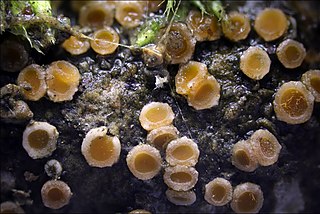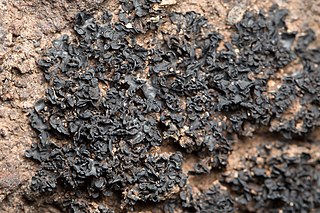
Gyalectales is an order of lichen-forming fungi in the class Lecanoromycetes. It contains 5 families, 18 genera and about 550 species.

The Arthoniaceae are a family of lichenized, lichenicolous and saprobic fungi in the order Arthoniales. The Arthoniaceae is the largest family of Arthoniales, with around 800 species. Most species in Arthoniaceae belong in Arthonia which is the largest genus with 500 species. The second and third largest genus is Arthothelium with 80 species, and Cryptothecia with 60 species.

The Pannariaceae are a family of lichens in the order Peltigerales. Species from this family have a widespread distribution, but are especially prevalent in southern temperate regions.

Lichinales is the sole order of ascomycete fungi in the class Lichinomycetes. It contains three families: Gloeoheppiaceae, Lichinaceae, and Peltulaceae. Most species are lichenized. Lichinales was proposed in 1986 by German lichenologists Aino Henssen and Burkhard Büdel. The class Lichinomycetes was created by Valérie Reeb, François Lutzoni and Claude Roux in 2004.

Gloeoheppiaceae is a family of ascomycete fungi in the order Lichinales. The family contains ten species distributed amongst three genera. Most species are lichenised with cyanobacteria. Species in this family are mostly found in desert areas. Modern molecular phylogenetics analysis casts doubt on the phylogenetic validity of the family, suggesting a more appropriate placement of its species in the family Lichinaceae.

Pannaria is a genus of lichen-forming fungi in the family Pannariaceae. The widespread genus contains an estimated 51 species, found primarily in tropical regions.
Edwardiella is a genus of fungi within the family Lichinaceae. This is a monotypic genus, containing the single species Edwardiella mirabilis. Aino Henssen named the genus after the Prince Edward Islands, the type locality of the type species.

Lempholemma is a genus of lichen-forming fungi in the family Lichinaceae.

Lichinella is a genus of lichen-forming fungi in the family Lichinaceae. It was circumscribed in 1872 by Finnish lichenologist William Nylander. Five species are accepted by Species Fungorum.
Lichinodium is a genus of filamentous lichens. It is the only genus in the family Lichinodiaceae, itself the only member of the order Lichinodiales. Lichinodium has four species. Previously considered part of the class Lichinomycetes, molecular phylogenetic analysis revealed that Lichinodium represents a unique lineage in the Leotiomycetes—the first known group of lichen-forming fungi in this class.
Pterygiopsis is a genus of fungi within the family Lichinaceae. It contains 11 species.

Pyrenopsis is a genus of lichen-forming fungi in the family Lichinaceae. It contains 12 species. The genus was circumscribed by the Finnish lichenologist William Nylander in 1858.
Zahlbrucknerella is a genus of filamentous, rock-dwelling lichens in the family Lichinaceae.

Thyrea is a genus of lichen-forming fungi in the family Lichinaceae. It contains four species that have been accepted by Species Fungorum. The genus was circumscribed by Italian lichenologist Abramo Bartolommeo Massalongo in 1856, with Thyrea plectospora assigned as the type species.

Peltula is a genus of small dark brown to olive or dark grey squamulose lichens. These lichens typically grow on rocks in arid and semi-arid environments worldwide. They consist of a fungus living in symbiosis with a photosynthetic partner, specifically a cyanobacterium of the genus Chroococcidiopsis. Peltula is the only genus in the family Peltulaceae, which belongs to the Lichinomycetes, a class of fungi that form lichens. The genus includes about 50 recognised species, which exhibit a variety of growth forms ranging from flat and crust-like to more complex, leaf-like structures. Peltula lichens play important ecological roles in harsh environments, contributing to soil stability and nutrient cycling.
Aino Marjatta Henssen, was a German lichenologist and systematist. Her father, Gottfried Henssen, was a folklorist and her mother was Finnish.

Heppia is a genus of olive, brownish, gray, or blackish squamulose, crustose, or peltate like lichens. Heppia was once the type genus of the family Heppiaceae, but that family was folded into synonymy with Lichinaceae.
Harpidiaceae is a small family of lichen-forming fungi, containing two genera and five species. It is of uncertain classification in the Pezizomycotina.

Peccania tiruncula is a species of saxicolous (rock-dwelling), squamulose to dwarf fruticose lichen in the family Lichinaceae. It was first described as a new species in 1878 by the Finnish lichenologist William Nylander, who classified it in the genus Omphalaria. The type specimen was collected by Johan Petter Norrlin in Biskra. Aino Henssen transferred it to the genus Peccania in 1990.

Gloeoheppia is a genus of lichen-forming fungi in the family Gloeoheppiaceae. It comprises five species. The genus is distinguished from similar-looking lichens like Heppia by its internal structure, the nature of its photobiont, and details of its reproductive structures.















